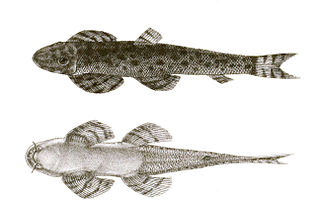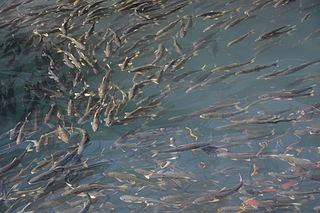
Cypriniformes is an order of ray-finned fish, including the carps, minnows, loaches, and relatives. Cypriniformes is an Order within the Superorder Ostariophysi consisting of "Carp-like" Ostariophysins. This order contains 11-12 families, although some authorities have designated as many as 23, over 400 genera, and more than 4,250 species, with new species being described every few months or so, and new genera being recognized frequently. They are most diverse in southeastern Asia, and are entirely absent from Australia and South America. At 112 years old, the longest-lived cypriniform fish documented is the bigmouth buffalo.

Cobitidae, also known as the True loaches, is a family of Old World freshwater fish. They occur throughout Eurasia and in Morocco, and inhabit riverine ecosystems. Today, most "loaches" are placed in other families. The family includes about 260 described species. New species are being described regularly.

The spined loach is a common freshwater fish in Europe. It is sometimes known as spotted weather loach, not to be confused with the "typical" weather loaches of the genus Misgurnus. This is the type species of the spiny loach genus (Cobitis) and the true loach family (Cobitidae).

The pond loach,, is a freshwater fish in the loach family Cobitidae. They are native to East Asia but are also popular as an aquarium fish and introduced elsewhere in Asia and to Europe, America and Australia. The alternate name weather loach is shared with several other Cobitidae, including the other members of the genus Misgurnus and the spotted weather loach. This term comes from their ability to detect changes in barometric pressure and react with frantic swimming or standing on end. This is because before a storm the barometric pressure changes, and this is known to make these fish more active. The pond loach also comes in a variety of colors, such as pink, orange, albino and gray.

Hemimyzon taitungensis is a species of ray-finned fish in the family Balitoridae that is endemic to Taiwan. It is a small freshwater fish currently known only from running waters of the Central Mountain Range of Taiwan at high and middle elevations. In contrast to H. formosanus, it appears to be a well-defined species with no signs of strong genetic structuring suggestive of cryptic species.

The stone loach is a European species of fresh water ray-finned fish in the family Nemacheilidae. It is one of nineteen species in the genus Barbatula. Stone loaches live amongst the gravel and stones of fast flowing water where they can search for food. The most distinctive feature of this small fish is the presence of barbels around the bottom jaw, which they use to detect their invertebrate prey. The body is a mixture of brown, green and yellow.

Oreonectes is a genus of fish in the family Nemacheilidae found in the rivers and cave of Asia. Many of these species are troglobitic.

Schistura is a genus of fish in the stone loach family Nemacheilidae native to the streams and rivers of the southern and eastern Asia. Some of these species are troglobitic.

Triplophysa is a genus of fish in the family Nemacheilidae found mainly in and around the Qinghai-Tibet Plateau in China. Currently, the genus is a mixed assemblage of species. Some lineages have been identified and treated as subgenera, but as Wikipedia follows Fishbase for fish species all but Hedinichthys have been treated as subgenera in Wikipedia, although Kottelat in his revision of the loaches did recognise them as valid. FishBase, however, includes these in Triplophysa without specifying subgenera and treats the names given by Kottelat as synonyms.

The Java loach is a species of tropical freshwater fish, an unbanded kuhli loach, native to the sandy streams of Southeast Asia. Its alternative common names include the black kuhli (loach), chocolate kuhli and cinnamon loach. It is common in the aquarium trade.
Beaufortia pingi is a species of river loach. It occurs in China and Vietnam. It inhabits fast-flowing hill streams and grows to 5 cm (2.0 in) standard length.

Balitora is a genus of fish in the family Balitoridae endemic to Asia.
Triplophysa longipectoralis is a cave-living species of stone loach with vestigial eyes. The fish lives in clear water at temperatures below 20 °C. The holotype was caught in Xunle town, Huanjiang Maonan Autonomous County in the Liu River basin, Guangxi, China and was described by Zheng et al. in 2009.
Triplophysa orientalis is a species of stone loach. It is a freshwater fish from the Tibetan Plateau and is endemic to China; its distribution includes the upper reaches of the Yangtze and Yellow Rivers, among others. It lives in a wide range of habitats, both lentic and lotic. The species is widespread but populations tend to be isolated and show high degree of genetic divergence.

Loaches are fish of the superfamily Cobitoidea. They are freshwater, benthic (bottom-dwelling) fish found in rivers and creeks throughout Eurasia and northern Africa. Loaches are among the most diverse groups of fish; the 1249 known species of Cobitoidea comprise about 107 genera divided among 9 families.
Homatula is a genus of stone loaches endemic to China.
Platypharodon extremus is a species of cyprinid fish endemic to the upper Yellow River basin in the Qinghai–Tibet Plateau of China. It is the only member of its genus, but is related to other schizothoracines like Aspiorhynchus, Chuanchia, Gymnocypris, Oxygymnocypris, Ptychobarbus, Schizopyge, Schizopygopsis and Schizothorax.

Gymnocypris przewalskii is a species of cyprinid that is endemic to the Lake Qinghai basin in China, where it is the dominant fish species. G. przewalskii is a planktivore with a main population that migrates from the lake to rivers to spawn and another that lives its entire life in the nearby Ganzi River. The species is listed as endangered on the China Species Red List due to overfishing and habitat loss, which has led to suspension of its commercial fishery four times since 1989.
Traccatichthys is a genus of stone loaches from southern China and Vietnam.
Travancoria elongata, which is also known as Periyar loach, is an endangered species of freshwater fish only found in Chalakudy River and Periyar River, from the family of Balitoridae (River loaches). These fishes grows up to 11 centimetres (4.3 in) long. Large-scale capture of these species from rivers in order to export them to the international market as ornamental fish has become a threat to this species. Included in the Red Data Book, they are on the verge of extinction.












